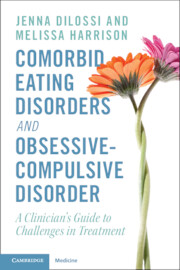 Comorbid Eating Disorders and Obsessive-Compulsive Disorder
Comorbid Eating Disorders and Obsessive-Compulsive Disorder from Part II - Clinical Pitfalls and Treatment Failures
Published online by Cambridge University Press: 14 December 2023
Exposure therapy is a widely recognized and effective treatment for OCD, but it may not work as effectively for EDs. Some of the reasons for poor delivery or treatment manual avoidance are known broadly, but hesitancy can be higher for ED clinicians specifically. EDs have a high mortality and self-harm rate and significant physiological comorbidities, making clinicians more hesitant to utilize certain interventions. Complexities such as starvation effects, the ego-syntonic presentation, and low motivation can compromise exposure therapy. There may be need for reassurance, safety behaviors, and distraction when the primary treatment goal is weight gain. Additionally, there are emotions outside of anxiety that are not effectively treated with exposure (i.e., guilt, disgust, anger). Uniquely, the fears and concerns associated with EDs are also present in the general population. Preoccupation with health, size, and weight is prevalent in society, which affects beliefs about the body and food. This may lead to clinicians overempathizing with patients and can affect the way they facilitate and process food and weight exposures during treatment, all complicating exposure therapy for EDs.
To save this book to your Kindle, first ensure [email protected] is added to your Approved Personal Document E-mail List under your Personal Document Settings on the Manage Your Content and Devices page of your Amazon account. Then enter the ‘name’ part of your Kindle email address below. Find out more about saving to your Kindle.
Note you can select to save to either the @free.kindle.com or @kindle.com variations. ‘@free.kindle.com’ emails are free but can only be saved to your device when it is connected to wi-fi. ‘@kindle.com’ emails can be delivered even when you are not connected to wi-fi, but note that service fees apply.
Find out more about the Kindle Personal Document Service.
To save content items to your account, please confirm that you agree to abide by our usage policies. If this is the first time you use this feature, you will be asked to authorise Cambridge Core to connect with your account. Find out more about saving content to Dropbox.
To save content items to your account, please confirm that you agree to abide by our usage policies. If this is the first time you use this feature, you will be asked to authorise Cambridge Core to connect with your account. Find out more about saving content to Google Drive.